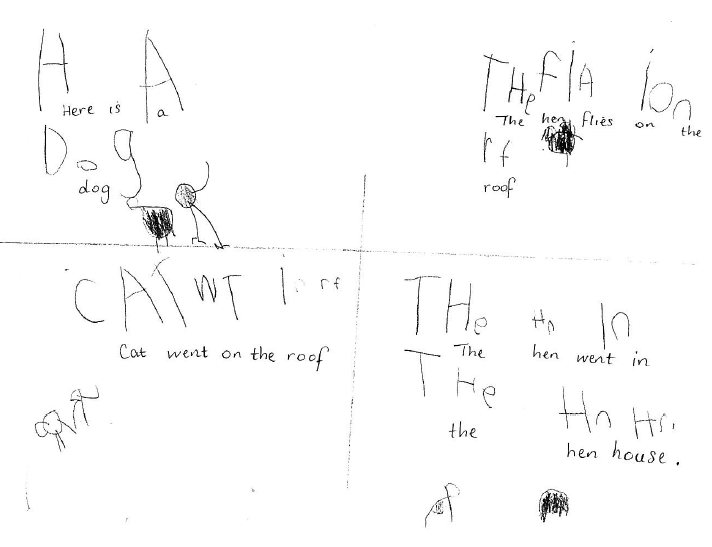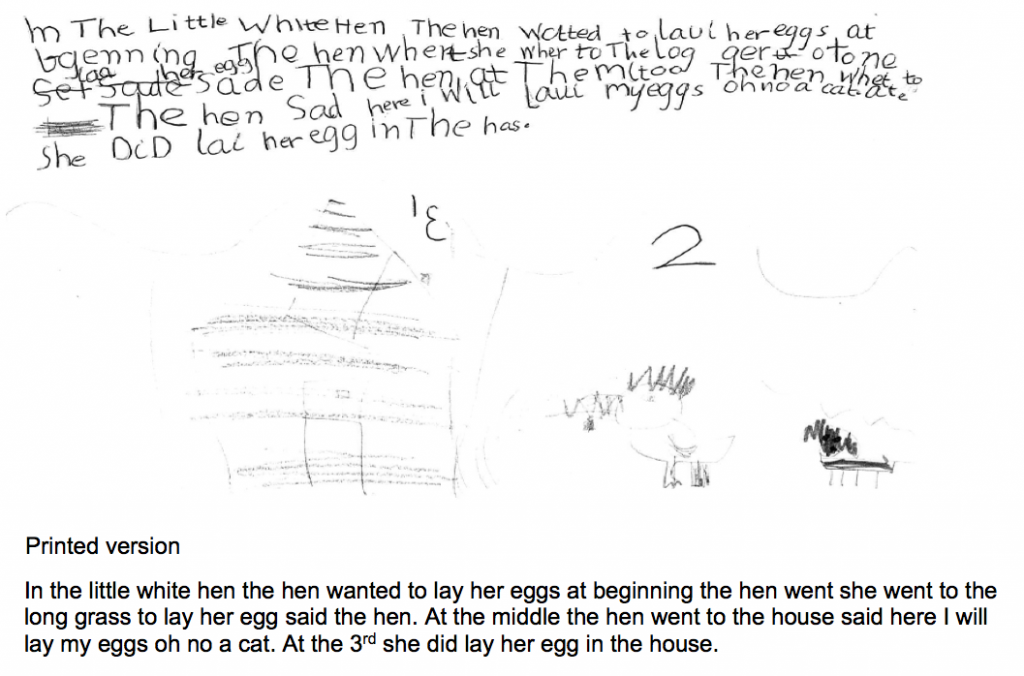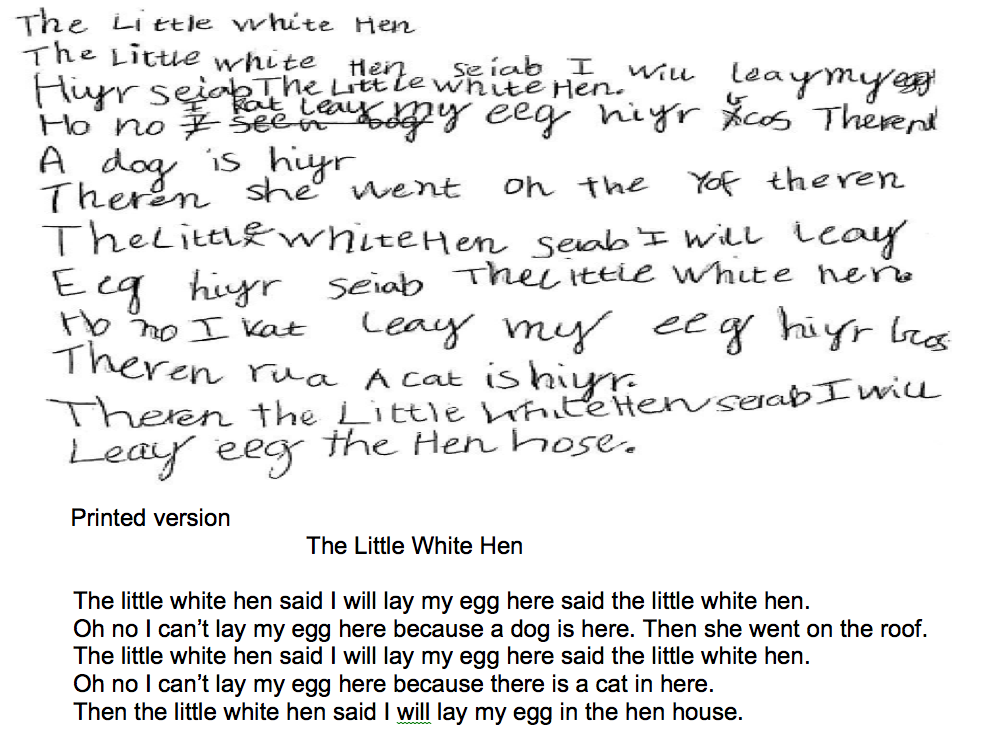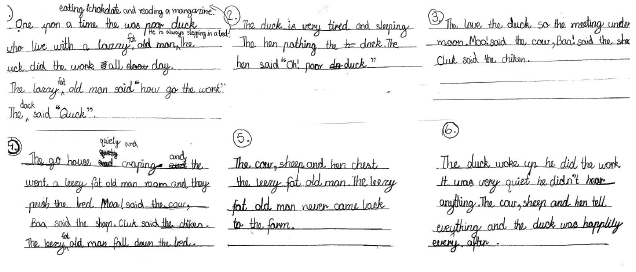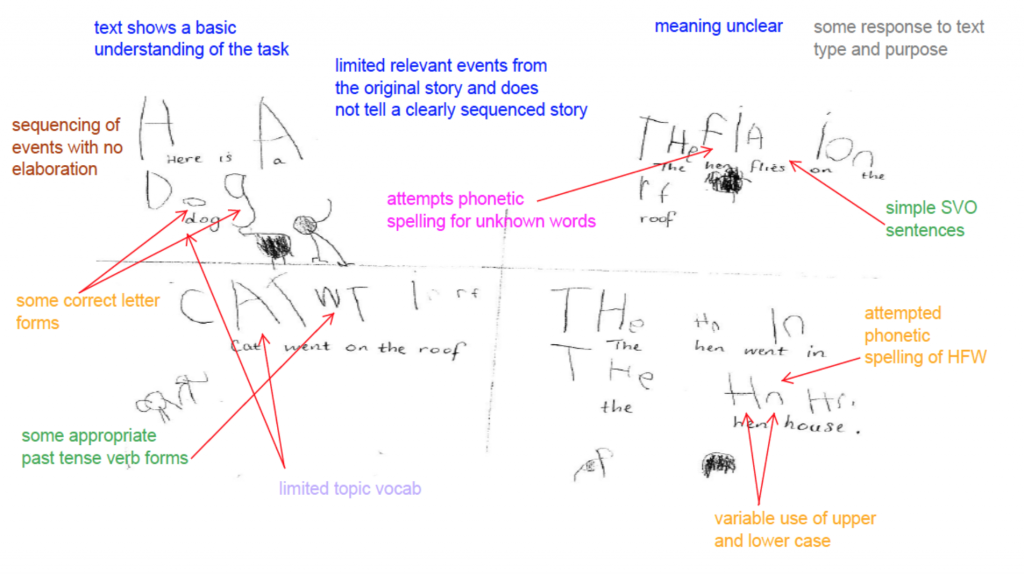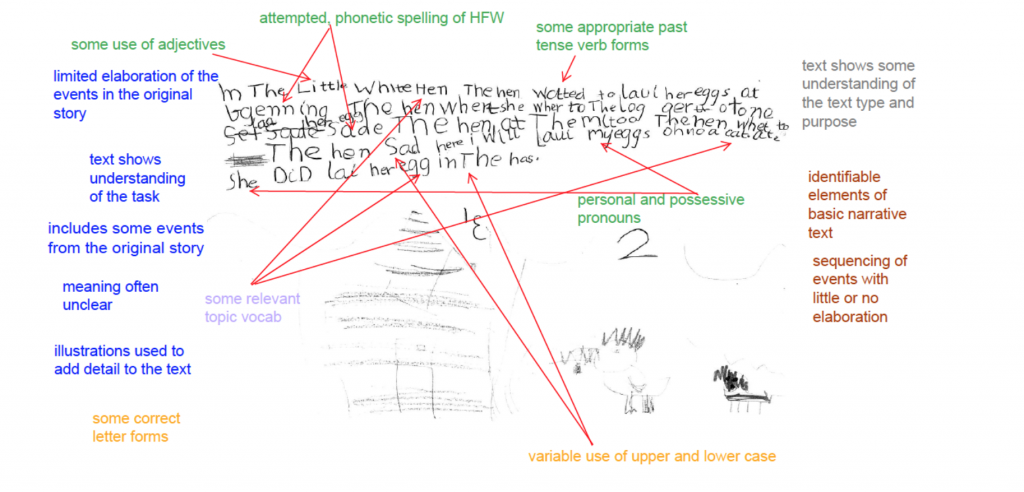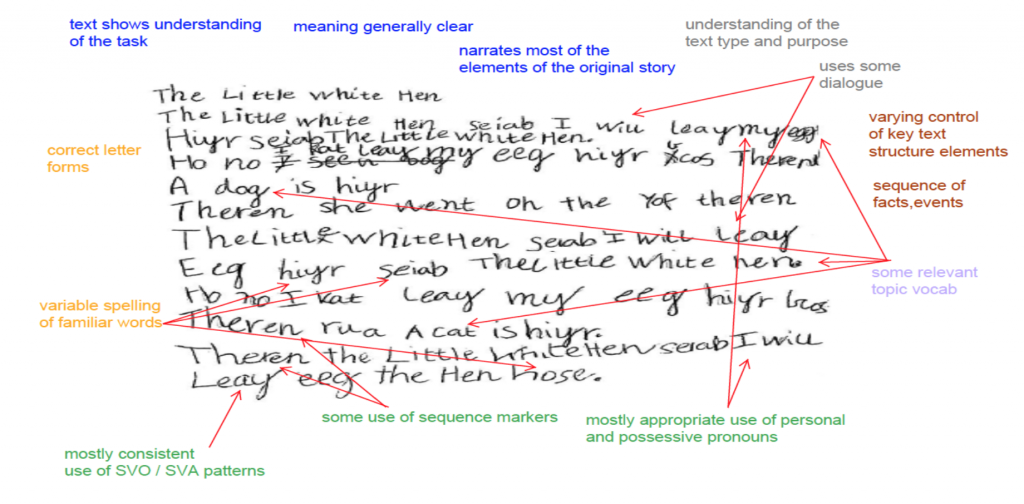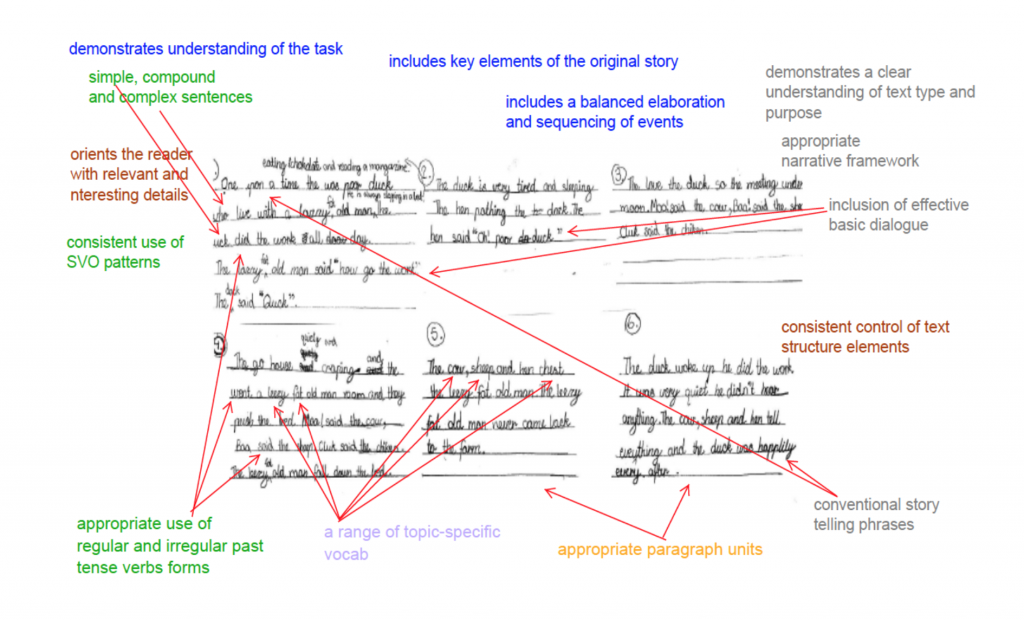5. Story retell
Please click on the toggles below to navigate through information on this assessment task and reveal the links for downloading task materials.
Task details |
|
| Name of writing assessment task | Story retell |
| EAL curriculum level range | A1, A2, BL, B1, B2, CL, C1, C2 |
| Text orientation | Imaginative |
| Task type | Extended response |
Task specification |
|
| Purpose | To assess students’ ability to retell a simple narrative. |
| Description | Students retell a story, in writing and through illustrations, by providing 4 or 6 sequenced illustrations and text in their retelling of the story. |
| Assumed knowledge and description |
|
Learning/teaching context |
|
| Language centre/mainstream class | Small group |
| Subject/key curriculum objectives, outcomes | English |
| Topic/teaching unit | Animals |
| Assessment conditions |
|
| Notes |
|
Task implementation |
|
| STAGE | ACTION STEPS |
| Pre-assessment activity |
|
| Assessment activity |
|
| Post-assessment activity |
|
Click here for the unmarked assessment criteria:
- TEAL Writing Task 5 -unmarked criteria sheet [PDF]
- TEAL Writing Task 5- unmarked criteria sheet [Word]
An explanation of the purpose, nature and use of criteria sheets is available at 4. Using the assessment criteria.
Purpose and value of task
This task assesses students’ abilities to retell a known story. The story chosen should be engaging, but told mostly through the illustrations so that students are not able to learn the original text verbatim. Well-chosen picture story books give students scope to tell their own story, and to elaborate on what they see in the illustrations. The task elicits narrative and story-telling language, and assesses the ability students have to use linguistic elements common to narrative and storytelling, such as past tense, adverbials of time and use of first- or third-person narration. This task is related to Oral Task 3: Story retell, to TEAL Oral Task 12: Retelling a folk story or legend, and TEAL Writing Task 16: A ghost story.
Contextual information
The students were prepared for the task by listening to the story several times, taking part in ‘shared book’ activities such as a modelled retell.
Commentary
The samples cover a wide range of stages, some students are at a very early stage of both English language development and writing development (and who are still working out the conventions of writing in English, such as basic sound-symbol relationships), and are therefore only able to write a small amount of text. Other samples show students able to deal much better with the challenges of writing in English but still only able to construct quite simple retells with little elaboration. As their proficiency increases the students are increasingly able to provide more details in their retell, and to add more conventional story-telling elements.
In this sample, even though the student is at a very early point in learning to write in English, a basic understanding of the task and the need to retell the story is shown. The student has followed the modelled text structure and has placed a sentence in each ‘box’, with some minimal illustration. The sentences however do not tell a coherent story.
The student uses a mixture of known words and attempts at spelling new words from the text, with the words being represented by one or two letters. The illustrations do not add detail or assist the reader in understanding the story. The student was able to read the story back to the teacher who has transcribed, in complete sentences, what the student was able to say.
The text shows that the student is still at a very early stage in being able to express a sequenced, coherent story, but has some important early understandings about writing in English, including some basic sound-letter relationships.
The student is able to form letters correctly, but does not show an understanding of when to use upper and lower case letters.
The marked criteria sheet shows that the student meets most criteria at level 1 of performance.
The student’s language use in this task is consistent with the descriptions of students at Level A1, Victorian Curriculum F-10 EAL.
TEAL Writing Task 5- criteria sheet- Sample 1
Using this assessment for further learning
(Select the points you think are currently of most importance to the student.)
- Ask the student to read their story. Add a few words like ‘cat’ and ‘dog’ to the student’s personal dictionary.
- Ask the student to suggest words that sound the same from their oral repertoire, and to add these to their personal dictionary or to a class word chart.
- Ask the student to illustrate, for example: sat, cat, mat.
- Point out when we would use upper and lower case letters in words such as ‘dog’ and ‘cat’.
- The student may be able to orally retell a fuller, more sequenced and detailed story, which can be scribed by the teacher and used for further reading and writing activities such as ‘story sequencing’ and ‘fill-the-gaps’ activities.
- The teacher could print a model representation of the student’s text to add to the portfolio alongside the original text.
Commentary
The student clearly understands the task. Although the text does not give an entirely coherent or structured retell, some key elements of the story are understandable. The illustrations add some information to the written text. The student has used the terms ‘beginning’ and ‘middle’ and ‘at 3rd’ to show the sequence of events, and how the story moves forward. A concluding sentence is provided: she did lay her egg in the house. Some dialogue is attempted: oh no a cat. The text is quite well placed on the page, and shows some evidence of planning, with the text at the top of the page and the illustration underneath.
The student uses common simple past tense forms correctly: wanted, said, went.
The student uses a mixture of spelling strategies in the text, including plausible attempts at unknown words, and correct spelling of high-frequency words. The use of capital letters is not consistent, but there is some evidence that the student understands the need for a capital letter at the start of sentences or new ideas, and perhaps for the story title at the beginning of the story. There is no other punctuation apart from a full stop at the end.
The student has been able to do some self-correction, crossing out some words and inserting others.
The marked criteria sheet shows that the student meets criteria at levels 1 and 2 of performance.
The student’s language use in this task is consistent with the descriptions of students at Level A1, Victorian Curriculum F-10 EAL.
TEAL Writing Task 5- criteria sheet- Sample 2
Using this assessment for further learning
(Select the points you think are currently of most importance to the student.)
- Ask the student to read the story, and encourage the student to do further corrections focusing on elements such as spelling, punctuation for showing sentence beginnings and endings, or correction of verb tense forms.
- The teacher can read the student’s text to the student and then ask him or her to talk about which bits of the story are missing, where they could be added and how further sequence words such as ‘then’ and ‘after that’ could be used in place of ‘beginning’ and ‘middle’. The teacher can scribe the missing elements for the student.
- The student may be able to retell a fuller, more sequenced and detailed story, which can be scribed by the teacher and used for further reading and writing activities such as story sequencing, fill-the-gaps activities.
- The teacher could print a model representation of the student’s text to add to their portfolio alongside the original text:
Commentary
The student has written a clear, mostly coherent text that tells an understandable story, with most of the key elements evident. A title is provided, on a separate line but there are no illustrations.
The student has attempted dialogue, which is not marked with punctuation. The dialogue is in present tense, while the rest of the story is generally in the past tense.
Use of upper and lower case letters is more consistent, with most sentences starting with an upper case letter, although all the words starting a new line are also capitalised.
The student fairly consistently spells high-frequency words correctly, but others such as here (hiyr), and said (seiab) are consistently misspelt and the phonetic attempts are not really plausible.
The student has been able to do some self-correction, crossing out some words and inserting others.
The marked criteria sheet shows that the student meets criteria at levels 2 and 3 of performance.
The student’s language use in this task is consistent with the descriptions of students at Level B2, Victorian Curriculum F-10 EAL.
TEAL Writing Task 5- criteria sheet- Sample 3
Using this assessment for further learning
(Select the points you think are currently of most importance to the student.)
- During a teacher-student conference encourage the student to read back the story. Ask the student to sound out the words ‘said’, ‘here’, ‘lay’ and ‘can’t’ and add them to their personal dictionary. Ask the student to highlight where these words are used in the text, so that they can be correctly written in the next draft.
- Read the text to the student and ask for help to add full stops at the end of complete ideas.
- Help the student to notice when to use capital letters – at the beginning of new sentences rather than at the beginning of every line.
- The student has successfully used dialogue in the retelling of the story so help him or her to notice and add punctuation conventions – inverted commas etc. around spoken dialogue to differentiate it from the rest of the text.
- Give the student time and support to write up and illustrate a final draft of the story to add to a portfolio.
- The teacher could print a model representation of the student’s final text to add to their portfolio alongside the final written text.
Commentary
The student has written an extended text, set out in six numbered boxes. The student has structured the story well so that it fits the layout of the page. The story is clear and coherent. Some storytelling conventions have been included, such as ‘Once upon a time’, and ‘Happily ever after’. Sentence structures and novel constructions: … so the meeting under the moon; old man fall down the bed; how go the work; are evidence of her level of both oral and writing development in English.
The student has written this first draft in preparation for publishing as a small booklet.
Dialogue is provided, sometimes indicated by quotation marks. The dialogue is in the present tense, while the rest of the story is generally in the past tense. The student’s verbs are consistently in the appropriate tense, with some errors: go (went to) house, how go (goes) the work, love (loved) the duck.
Use of upper and lower case letters are more consistent than previous samples, with most sentences starting with an upper case letter. Basic punctuation, full stops and commas are mostly consistently correct.
The student consistently spells high frequency words correctly, but some others such as ‘they’ are often incorrect. The student uses strong knowledge of sound-letter relationships in English to spell versions of less well known words: chest (chased), leezy (lazy) and chiken.
The student has been able to independently self-correct, crossing out some words and inserting others.
The marked criteria sheet shows that the student meets criteria at levels 3 and 4 of performance.
The student’s language use in this task is consistent with the descriptions of students at Level C2, Victorian Curriculum F-10 EAL.
TEAL Writing Task 5- criteria sheet- Sample 4
Using this assessment for further learning
(Select the points you think are currently of most importance to the student.)
- During the teacher-student conference, the teacher could highlight the misspelt high frequency words for the student to self-correct for their next draft.
- The teacher could also highlight the use of tenses in the student’s text and see if the student can self-correct replacing present tense forms with past tense forms where appropriate.
- Give the student time and support to write a final draft to add to their portfolio.

